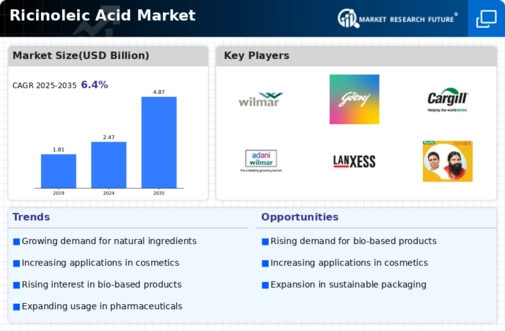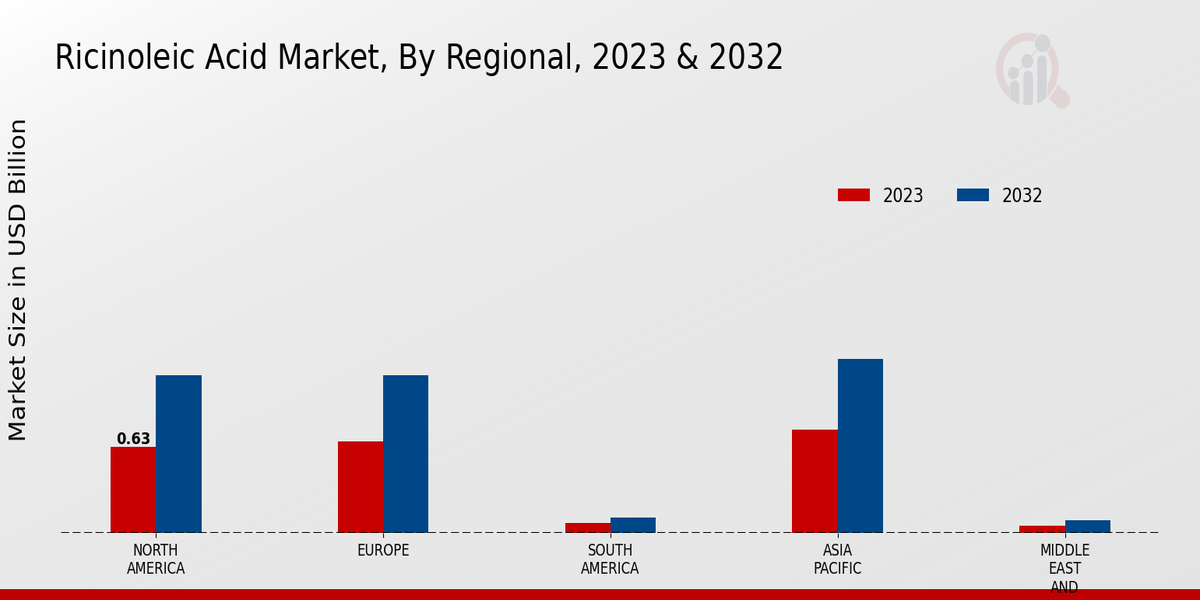Market Growth Projections
The Global Ricinoleic Acid Market Industry is projected to experience substantial growth in the coming years. With a market value anticipated to reach 2.47 USD Billion in 2024 and further expand to 4.87 USD Billion by 2035, the industry is poised for a promising trajectory. The compound annual growth rate of 6.37% from 2025 to 2035 indicates a robust demand for ricinoleic acid across various sectors, including personal care, pharmaceuticals, and industrial applications. This growth is likely driven by the increasing preference for sustainable and bio-based products, as well as the expanding awareness of the health benefits associated with ricinoleic acid. The market's future appears bright, suggesting a dynamic evolution in response to consumer and regulatory trends.
Rising Awareness of Health Benefits
Rising awareness of the health benefits associated with ricinoleic acid is influencing the Global Ricinoleic Acid Market Industry. Research indicates that ricinoleic acid possesses anti-inflammatory and analgesic properties, making it a valuable ingredient in pharmaceuticals and dietary supplements. As consumers become more health-conscious, the demand for products containing ricinoleic acid is likely to increase. This trend is further supported by the growing interest in natural remedies and holistic health solutions. The market's expansion in this sector could contribute to its overall growth, potentially reaching 4.87 USD Billion by 2035, as more individuals seek out health-promoting ingredients.
Growing Demand for Bio-based Products
The Global Ricinoleic Acid Market Industry is witnessing an increasing demand for bio-based products, driven by a global shift towards sustainable and environmentally friendly alternatives. Ricinoleic acid, derived from castor oil, serves as a renewable resource in various applications, including cosmetics, lubricants, and coatings. This trend aligns with the global push for sustainability, as consumers and manufacturers alike seek to reduce their carbon footprint. The market is projected to reach 2.47 USD Billion in 2024, reflecting a growing preference for natural ingredients over synthetic ones. As awareness of environmental issues continues to rise, the demand for ricinoleic acid is likely to expand further, potentially leading to a more robust market landscape.
Innovations in Industrial Applications
Innovations in industrial applications are propelling the Global Ricinoleic Acid Market Industry forward. The compound is increasingly employed in the production of bio-lubricants, surfactants, and other industrial chemicals, which are gaining traction due to their eco-friendly attributes. As industries seek to comply with stringent environmental regulations, the adoption of ricinoleic acid as a sustainable alternative is likely to increase. The anticipated compound annual growth rate of 6.37% from 2025 to 2035 indicates a robust market trajectory, driven by the need for sustainable industrial solutions. This shift not only enhances the market's potential but also aligns with global sustainability goals.
Expanding Applications in Personal Care
The Global Ricinoleic Acid Market Industry benefits from its expanding applications in the personal care sector. Ricinoleic acid is increasingly utilized in formulations for skin care, hair care, and cosmetics due to its moisturizing and anti-inflammatory properties. As consumers prioritize health and wellness, the demand for natural and effective ingredients in personal care products is on the rise. This trend is expected to contribute to the market's growth, with projections indicating an increase to 4.87 USD Billion by 2035. The versatility of ricinoleic acid in various formulations enhances its appeal, suggesting a promising future for its use in personal care applications.
Regulatory Support for Natural Ingredients
Regulatory support for natural ingredients is playing a crucial role in the Global Ricinoleic Acid Market Industry. Governments worldwide are increasingly endorsing the use of bio-based and natural products, which enhances the market's credibility and acceptance. This regulatory backing not only encourages manufacturers to adopt ricinoleic acid in their formulations but also reassures consumers about the safety and efficacy of these products. As regulations continue to evolve in favor of natural ingredients, the market is expected to benefit significantly, potentially achieving a compound annual growth rate of 6.37% from 2025 to 2035. This supportive environment fosters innovation and growth within the industry.










